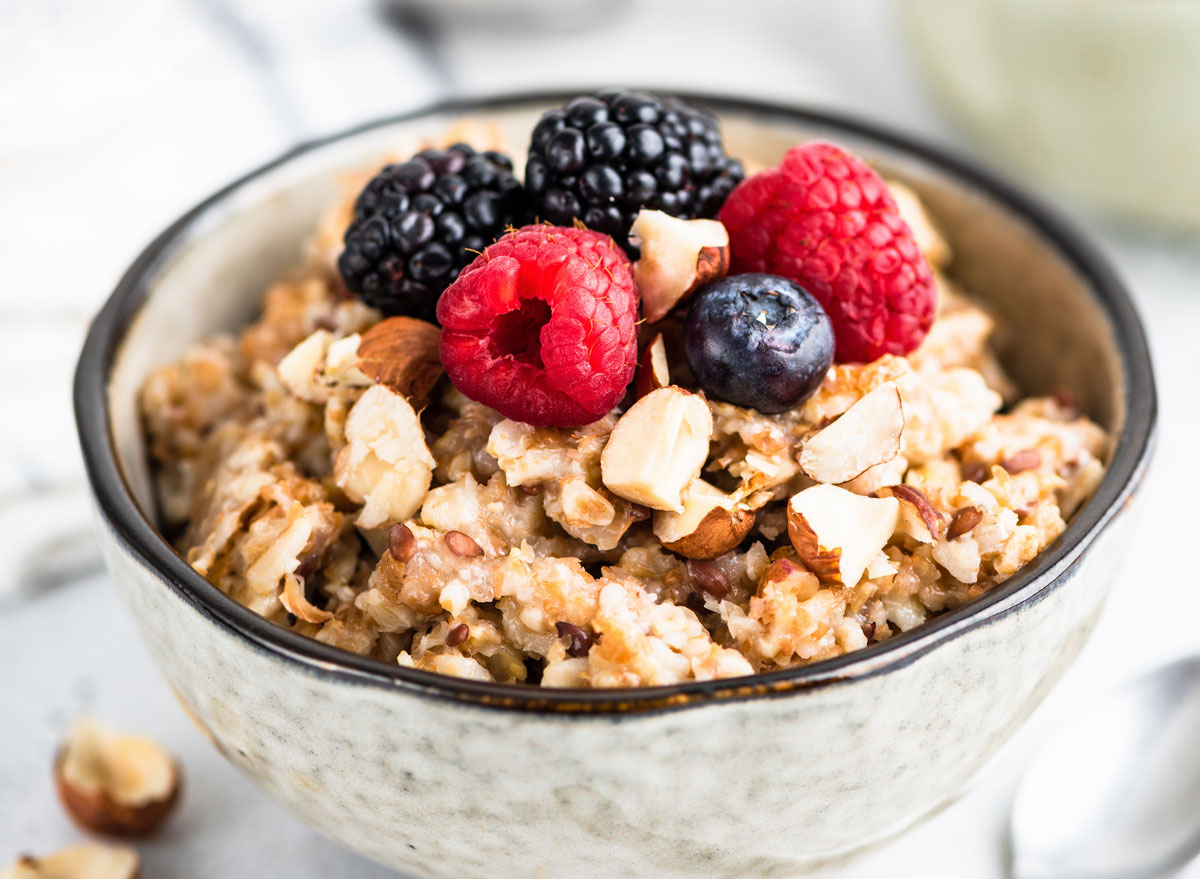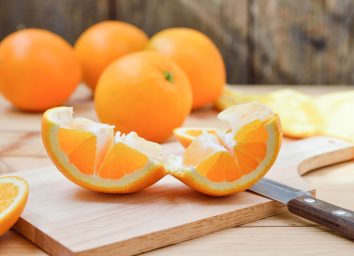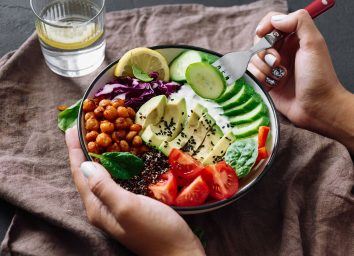7 Healthy Eating Habits For Women, Say Dietitians

Most healthy eating habits fit for everyone—both men and women. And while it’s important for everyone to set healthier eating habits for themselves so they can feel their best, it’s also important to look at eating habits for men and women separately. Their nutritional needs based on their different hormones and body types are important to take note of, which is why we established a few healthy eating habits for women to follow.
In order to do so, we asked a variety of registered dietitians to weigh in on what the best healthy eating habits are for women, and why women should listen. From lifestyle changes to the types of foods that are best for their bodies, here are the best healthy eating habits for women to follow. And for more healthy eating tips, be sure to check out our list of 21 Best Healthy Cooking Hacks of All Time.
Focus on portion control.

“It’s so important for women to focus on portion control and portion awareness rather than obsess about calories,” says Lisa Young, PhD, RDN, and author of Finally Full, Finally Slim. Young is also an adjunct professor of nutrition at NYU. “Enjoy balanced meals—eating nutrient dense choices from a variety of food groups. As a portion size advocate, ideally, 1/2 the plate should be composted of fruits and veggies, 1/4 healthy starch (brown rice, quinoa, sweet potato), and the other 1/4 healthy protein (fish, chicken, beans, eggs).”
Along with dividing up your plate properly, Young encourages women to focus on eating real foods and to eliminate the ultra-processed stuff.
“Women should enjoy a diet composed of whole foods including plants, including fruits and veggies, unprocessed whole grains, seeds, and nuts, with lean proteins like beans and fish,” says Young. “And limit ultra-processed foods with added sugars or refined white flours, and minimize processed meats. And eat what you love!”
Start portioning out your meals with our 18 Easy Ways to Control Your Portion Sizes.
Fit in fiber in every meal.

“Fiber is an often overlooked but vital nutrient for gut health, weight management, lowering cholesterol, and regulating blood sugar levels,” says Hannah Ackermann, RD. “By definition, fiber is the non-digestible part of carbohydrates that adds bulk to food. Consuming more fiber-rich foods helps you feel fuller after eating, so you generally eat less throughout the day. In addition, as fiber swells in the stomach, it absorbs and removes fat and calories and boosts metabolism. Fiber-rich foods can actually help combat insulin resistance by slowing down how quickly sugar is metabolized in the intestine and reducing the impact of sugar on the blood.”
Here are 20 Different Ways to Eat 28 Grams of Fiber a Day.
Prioritize sources of iron during menstruation.

Kerry Jones, MPH, RDN, LDN, and CEO of Milestones Pediatric & Maternal Nutrition, says that it’s important to consume iron-rich foods during a woman’s menstruation to compensate for blood lost during that time period.
“Iron-rich foods include meat and seafood,” says Jones. “You can also get iron from plant sources, such as nuts, beans, some vegetables, and fortified grains, but these sources should be paired with a food rich in vitamin C to increase the amount of iron the body is able to absorb.”
Here are 6 Signs of an Iron Deficiency You Should Never Ignore.
Listen to your body and your satiety cues.

“One of the best eating habits for women is to listen to their bodies! For too long we’re taught to rely on external tools like meal plans, time of day, calories, and points systems. This can create distrust and disconnect from our bodies,” says Katherine Kimber, RD. “A good place to start is to let natural hunger signals lead the way when deciding when to eat. Quite often people know what it feels like to get super hungry, and super stuffed, but struggle with the subtleties in the middle.”
Kimber suggests looking for certain hunger cues that may not seem like hunger cues, which can include your mood, energy levels, headaches (or even poor concentration), stomach aches, and even body cues like salivating and feeling like your blood sugar is low.
“A common mistake I see is not eating enough in the day, and backloading food to the evening,” says Kimber. “Hunger hormones are ramped up in the evening, and this coupled with not eating enough in the day through trying to control or being at work and busy can result in feeling out of control later on. It can leave us feeling more susceptible to binge eating, eating quickly, cravings, which can increase stress levels, and lead to feelings of guilt and shame or feeling like we need to compensate. Eating in accordance with hunger, with regular meal patterns can help with keeping the body happy!”
Emphasize eating a variety of foods.

“Within each of the food groups, women should consume a variety,” says Jinan Banna, PhD, RD. “This means not always eating blueberries as your serving of fruit, but sometimes choosing cantaloupe, watermelon, or dragon fruit. All contain different nutrients the body needs. It’s easy to get stuck in a food rut if one is caring for children or aging parents and is short on time, but it’s important to be creative and buy different foods to make sure the body gets everything it needs.”
Here are the 15 Best Frozen Fruits & Vegetables to Keep on Hand for easy meals.
Get enough calcium for bone health.

Jones also mentions that it is important to keep your bones strong by eating enough calcium-rich and vitamin D-rich foods, as well as regularly exercising. She suggests exercises that include either jogging or walking, as well as weight training.
“Women are at an increased risk of osteoporosis. Therefore, working to maintain your bone strength and health is important,” says Jones. “Make sure to consume calcium-rich foods, such as dairy products, vegetables (cabbage, kale, broccoli), and fortified-products (some orange juices and grains), and vitamin-D foods, such as egg yolks, fatty fish (trout, salmon, tuna), beef liver, and fortified-products (dairy products and some plant milks).”
Melanie Steele, RD from Vancity Nutrition, has a few solutions for anyone focusing on a dairy-free diet but still looking to increase their calcium intake. “For those that don’t enjoy dairy, good sources include tofu (if prepared with calcium sorbate—check the label), white navy beans, fish with bones (think canned salmon), molasses, and cooked green cabbage leaves,” says Steele.
Plan out healthy meals.

Women are often focusing on the needs of others throughout the day—leaving very little time to focus on themselves. Brenda Braslow, a registered dietitian for MyNetDiary, says it’s important to focus on personal goals and to have a game plan for the day.
“Women often find themselves busy caring for others and it is important to take the time to plan healthy meals and snacks to meet their own needs,” says Braslow. “Eating consistent meals can help prevent becoming overly hungry and help maintain energy levels throughout a busy day.”
For simpler meals, stock your freezer with a few healthy weeknight meals, prep a few healthy snacks, or prep a few of these high-protein lunches to get you through the day. Don’t have time to cook? These healthy no-cook recipes should help!








